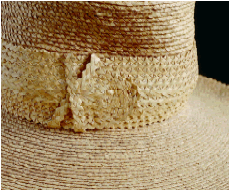Case study two - step 5:
Analyse the item’s fabric, design, manufacture and condition
Document how an object works, what it is made of, its manufacture, patterns of wear, repairs and adaptations. Record the object’s condition. (This step may be part of your cataloguing procedures.)

Cabbage tree hat example:
In common with other cabbage tree hats, this example was made by first boiling and bleaching the palm leaves. The leaves were then stripped into narrow widths using a variety of tools and blades—the width of the strip affecting the fineness of the plait. The strips were plaited together, this one with five strands. To make the hat, the plait was wound from the crown out, overlapping the plait beneath, and then sewn down to make the high crown and wide brim of this example. Additional blocking and steaming might refine the shape. This example has a worked band of plait around the crown. It is lined and has the owner’s name inside the crown, and a leather thong for fastening under the chin.